At the time of writing in May 2021, the Coronavirus stripped many people from their jobs and made it impossible for some to find work. Many people are now trying to work remotely as freelancers. Becoming a freelancer seems frightening without experience, but it’s easier than you think.
I had zero experience when I started, but I’m now a full-time freelancer after doing a ton of research and trial and error. All I used was a reliable freelancing platform. I’ll show you exactly what to do, so you can start freelancing, too. Here are the practical steps you’ll be taking:
- Understand what freelancing is about
- Evaluate your skills and create a portfolio
- Find a reliable freelance platform
- Verify and set up your profile for success
- Define your target clients
- Learn to be more personal
- Craft your proposals and bid to get your first client
- Follow up with clients and set expectations
- Complete the work as promised
- Get repeat clients and land new ones
Keep on reading as I’ll explain in detail how you should follow each of the steps. I want to reassure you that anyone can become a freelancer, regardless of your background.
You need to put in the time and effort, and as cheesy as this sounds, don’t give up. Giving up early is one of the many mistakes new freelancers make. We’ll talk about some other mistakes near the end.
1. Understand What Freelancing is About

If you’ve ever searched online about how to make money remotely, you’ve probably heard of freelancing.
I’d bet that you heard about freelance writing in particular. I want to quickly point out that there are countless opportunities beyond freelance writing.
You can be a freelancer for anything, including graphic design, web design, social media management, marketing, coding, tutoring, event planning, data management, and so much more!
The list is endless.
Feel free to check out this list of common freelance jobs you can take.
Click the boxes below to see detailed explanations for commonly asked questions about freelancing. You need to understand what freelancing is so you know exactly what you’re getting yourself into.
Definition of being a freelancer?
In a nutshell, being a freelancer means you’re working as a self-employed individual or company. You find clients to work with, and you complete specific jobs they assign you.
If you find a client to work with, you’re typically not an employee for their business. I say typically because you can be an employee if you form a contractual agreement with your client. In addition, some clients may ask you to sign paperwork before you start working together, so make sure you read the terms carefully before accepting the job.
Types of freelancing jobs?
As I mentioned earlier, there are all kinds of freelancing jobs. There are also uncommon jobs such as product and game testing and participating in surveys. Some freelance platforms even allow clients to post very unusual jobs such as casual talking or trying to provide comfort.
I know that may sound unusual, but if the job is within the platform’s terms and conditions, it’s not a problem. Of course, if you find a job that seems like it would be outside the T&C, check to make sure it’s not before accepting the job. You should also report any job that seems sketchy.
Age to start freelancing? (With a warning)
From what I’ve researched, most freelancing platforms allow you to sign up when you’re at least 16 years old, but some require you to be 18. Some platforms allow teenagers around 14 to sign up with specific conditions. I never looked into them myself, but kudos to you if you’re reading this guide at 14 years old.
Depending on where you live and the platform you choose, the age you can start freelancing will vary. Always check your local legislation and laws to see if you’re eligible to make money online from clients from around the world. Almost every freelancing platform will require you to submit some form of identification, such as a driver’s license, which you can usually get when you turn 16. It’s pretty simple.
Warning!
Never lie about your age and identity as you’ll be purposely breaching every platform’s terms and conditions. If you somehow get away with it now, it might come back to haunt you later. You’ll most likely lose your account forever.
What you need to get started
Assuming you’re doing all of your freelance work online, all you need to get started is a computer and a stable internet connection.
However, let’s pretend you’re looking to be a freelance graphic designer as an example. In this case, you’ll need all the necessary software and tools to design what your clients are looking for – the platform won’t provide those to you.
Just to be clear, there are no freelance architect jobs that’ll require you to build anything remotely. It’s possible, however, if you’re able to meet your client in person.
How much money can you earn?
Here’s the golden question you’ve been looking for.
How much money can you really earn freelancing? You can earn as much money as you want. No platform will limit the amount of money you can make as it doesn’t make sense for their business. When you make money, so do they, and I’ll explain how.
Almost every platform takes a commission out of every payment you receive, anywhere from as low as 1-2% to over 20%. They’ll usually take a higher commission first until you reach a specific threshold or requirement before you can receive commissions as low as a few percent.
Every platform is different, so make sure you read the terms carefully before making any commitments.
Don’t let this discourage you from getting started. These commissions are in place to help ensure the platform stays active and safe to use.
You want a reliable workplace to find clients, make a living, ask for help when needed, and grow your business, right? That’s what these commissions are for – to help make sure you can continue making money online safely.
How do you get paid?
Getting paid is pretty easy as long as you’re using a reliable freelancing platform.
Generally, after you’ve verified your account, you just have to go to the withdrawal page and make a request. The withdrawal method will depend on what the platform offers. A direct deposit to your bank account, PayPal, and Wire Transfer are usually always available from my experience.
Advantages and disadvantages of freelancing?
There are several advantages and disadvantages of freelancing that you’ll want to take note of:
Advantages
- Working remotely. You’re able to work from home or remotely at any place you feel most comfortable. However, this can be a disadvantage if you prefer working face-to-face.
- Less risk of getting sick. Especially as the pandemic gets worse, or during flu seasons, you’re far less likely to get sick if you’re not around many people.
- Generally able to work your own hours. When working with freelance clients, they usually just want you to complete jobs by a specific date. Working hours aren’t important unless they need to communicate with you periodically. The bottom line is to finish the job on time!
- Choosing jobs you want to do. When becoming a freelancer, you have the option to take on any jobs you’d like, and they can be in a wide range of categories/niches. If your primary skill is graphic design, you can still take on English teaching jobs if you want to give yourself a break from designing.
- The pay can be incredible. One of the best advantages of freelancing is that you can usually negotiate the compensation you wish to receive (unless the client states that their budget is fixed). Suppose you’re dealing with a client with a higher budget and can prove that you can do an exceptional job. You can sell yourself and negotiate the compensation to earn more money than expected. A job that you’d typically charge $100 for, you could charge double.
- Countless opportunities to grow. As you’re picking various jobs to work on, you’re giving yourself more opportunities to expand your skillset. There’s an endless number of entry-level jobs where clients need some basic help, for example, data entry. From here, you may learn to use new software you’ve never used before and learn new skills along the way. It’s like taking an entry-level job in person. Who knows, you might even start growing your freelance career in another niche!
- Becoming more independent. By growing your freelance career, you’re learning to become more independent as you are essentially your own boss. Your success as a freelancer is only dependent on you. You’re not going to have anyone to blame if things get tough. As you learn some real hard skills, you may even want to consider opening your own freelancing agency where you hire and train others to do the work for you.
Disadvantages
- Lack of face-to-face interaction. If you’re someone who prefers communicating and working together with others in person, then freelancing may be difficult for you. Of course, you’ll be able to communicate with your clients. It’ll just most likely be through a screen. If it helps, there are freelance jobs that require you to attend meetings. You just have to find the right job.
- A slow start. For any new freelancer with an empty profile, it’s going to take some time to find your first client because you’re new. Nobody has left you a review to give proof that you’re capable of what you say you are. But once you get that first client, you’ll start to find more clients much easier. Later, I’ll show you the best things you can do to secure your first client.
- Being your own boss. Some may not consider this to be a disadvantage. But for those who have never worked independently like a freelancer, it can feel pressuring. You’re fully responsible for your success, and ultimately, how much money you make. Finding enough work to maintain a steady income stream will be challenging. However, it’ll feel EXTREMELY rewarding when you make it happen.
- Must be willing to get competitive. Especially during a pandemic where more people are looking for ways to make money from home, you must compete and beat the competition. If you’re applying for a graphic design job along with 30 other freelancers, you better be ready to do a darn good job. I’ll teach you some things you can do to beat the competition later on.
- No employee benefits. As a freelancer, you won’t receive employee benefits such as health insurance or paid vacation days. You should always save some money in case of an emergency.
If you’re feeling a bit intimidated or overwhelmed with information, don’t worry because anything new to you will feel that way.
I just want to make sure that you have a general understanding of what freelancing is about. This way, there won’t be any surprises when you get started. If you have any more questions about freelancing, feel free to ask me through my contact form.
2. Evaluate Your Skills and Create a Portfolio
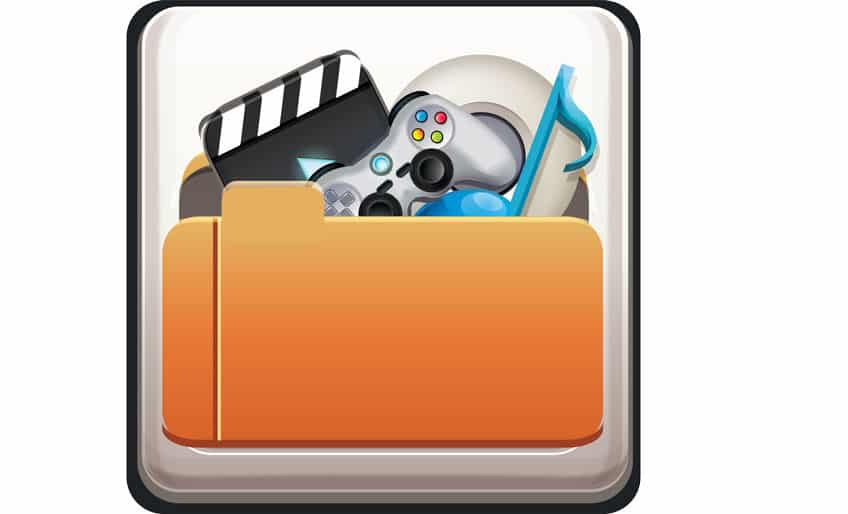
Now that you have a good understanding of what freelancing is, the next step is to evaluate your skills and then create a freelance portfolio.
Right away, if the first thing you thought to yourself was that you have no skills, then you’re not thinking clearly enough. Everyone has skills in something, you just haven’t realized it. For this step, you need to first evaluate your skills and then create a portfolio.
How to evaluate your skills
1. Write down what you know or think you’re good at
Do this by writing everything down on a piece of paper. Start with your hard skills such as programming, graphic design, guitar, tutoring, and acting. Think generally when you’re doing this as well and write down as many things as possible.
2. Decide on your best skills
Once you have your big list in front of you, go through it and underline your best skills. If your best skills aren’t hard skills, do some research to find a hard skill that aligns with them. For example, if one of your best skills was being good at talking to people, a hard skill could be customer service. Or, if a best skill is being able to type fast, a hard skill could be data entry.
Referring to my examples, it doesn’t matter whether you’ve been a customer service representative or a data entry clerk before. It just means you have the skills to become one.
Look over your top skills and decide on the one you’d like to start freelancing for. I highly recommend picking the one you’re the best at because you can always freelance for other skills later on.
Questions to help evaluate your skills
- What are my hard skills?
- What do my friends and family think I’m good at?
- Can I type fast, and do I like to write?
- Am I an analytical or creative thinker?
- What did I excel at in high school, college, or university?
- What do I enjoy doing every day?
- What’s important to me?
- Are my English or language skills excellent?
- What did I do well in the past?
- What were my previous jobs?
- Am I a people person?
- What are my hobbies?
- What do I want to be good at, and what is my dream job?
- Am I naturally good at something?
- Do I like teaching others?
- Have I won any awards?
- Am I good with numbers?
- What are my greatest strengths and weaknesses?
- Is there anything that makes me stand out?
- What have I done since I was little?
Creating Your Freelance Portfolio
What is a freelance portfolio? A freelance portfolio is a gallery of your work that illustrates your skills for potential clients. It’s working proof to show that you’re capable of what you claim you can do.
The freelancing platform that I recommend later allows you to build your portfolio directly on the site. All you need to do is upload the files and images that you want to showcase. If you plan on using the platform I recommend, you can move on to Step 3 of this guide. Otherwise, you’ll need to create a portfolio website.
Already have a freelance portfolio?
If you already have a portfolio of your work related to your chosen freelancing skill, feel free to skip this step. Just make sure your portfolio is easily accessible on the internet. In other words, don’t make your clients request a password or need to dig through several pages to find your work.
Also, make sure you only have your best work in your portfolio. It may be tempting to include everything you’ve ever done, but avoid doing so. Keep everything organized and easy to navigate through.
How to create an online freelance portfolio
1. Collect relevant work samples
Go through everything you need to showcase your relevant work samples, including images, models, videos, files, graphs, etc.
2. Build your freelance portfolio website
As I mentioned earlier, if you plan on using the same platform I use, you can move on to Step 3. Otherwise, you’ll need to create your portfolio using a website builder like Wix, Squarespace, Weebly, or WordPress.
As much as I’d like to help you create your portfolio website, you’ll need to work it out yourself. Building one isn’t as difficult as you think as you can simply use an existing template. There are plenty of guides and video tutorials available online. YouTube is a great source to find guides.
3. Keep things simple
After your website is up and running, make sure you’ve kept everything as smooth and simple as possible. Go with an easy-to-remember domain name, ensure that everything is easy to find, your projects are categorized and labeled, and that the website loads quickly.
4. Be descriptive with your work samples
Every project you upload on your portfolio should be worth looking into. Ensure you have a proper title and description and include any files or images your clients may want to see. If there were any results or interesting points to note, be sure to include them no matter how significant. Talk about the project as if it was going to land you a job.
5. Keep your portfolio up-to-date
As you complete new projects or even find existing ones, make sure you’re keeping your portfolio up-to-date with your best work. Remember, having a great portfolio can land you some fantastic jobs.
Don’t have work samples?
If you don’t have relevant work samples, demonstrate your skills using someone else’s work.
For example, let’s say you want to be a freelance writer, but you’ve never done any writing work before. You can take a passage out of an article, show how you’d improve it, and then describe your thought process.
You can use the same idea for any niche. Since you don’t have work samples, you need to get creative using other people’s work. Of course, make sure to give the reference document, file, spreadsheet, etc., proper credit and let your clients know that it’s not your original work.
3. Find a Reliable Freelancing Platform

Once you’ve evaluated your skills to find the niche you want to freelance in and prepare your portfolio, you can start looking for a reliable platform to use.
There are a large number of freelancing platforms available on the web, many of which are reliable.
So, how do you choose the right one?
Remember, we’re looking at the perspective of someone looking to work as a freelancer and not a client.
Factors to consider when choosing a freelancing platform
Here are the most important factors to consider when choosing a freelancing platform:
- Budget. Almost every reliable freelancing platform will have various plans for you to choose from. The platforms usually give you a free plan and then a range of paid plans. The free plans will be pretty bad as you won’t be able to bid on many jobs. You’ll need to invest some money to get a plan that’ll allow you to bid on many jobs. This is especially true if you’re just starting, but we’ll touch on that later. Make sure you find a platform that’s well within your budget, and don’t expect to make back the cost of the plan right away.
- Your skillset. Some platforms are designed for specific skillsets. You’ll want to make sure that you find one with clients looking for your skillset. Even if your skills are uncommon, most platforms should be fine to find work.
- Reliability. Reliability is everything. A reliable platform provides certainty that you’ll be paid for the work you complete. The platform should also have all the features you’d expect. This includes supportive staff members, secured payment processing and withdrawal methods, reasonable terms and conditions, website security, and more.
- Competition. You may find that the competition can be extremely tough for new and existing freelancers on some platforms. Some platforms only accept industry professionals. Therefore, the competition is extreme. You may even find that the competition is still tough on platforms that accept anyone. But don’t worry, I’ll teach you how to beat the competition later on.
- Job postings. Another important factor to consider is how frequently the platform is posting new jobs. It’s pointless to use a platform that only offers 1 or 2 job postings for the niche you’re in, especially if there’s competition and you’re competing as a new freelancer. You’ll want to find a platform with enough clients to be posting dozens of jobs every day for the niche you’re in.
- Project fees/commission. Project fees are a big concern when it comes to using freelance platforms. Every platform you use will take a percentage of your earnings, and it can range anywhere from a few percent to over 20%. Depending on the platform, it’s possible to decrease the project fees as you complete more and more jobs.
List of reliable platforms
From my research and experience, here are some reliable platforms to consider that are based on the factors listed above. The first on the list, Freelancer, is the platform that I use and recommend for new freelancers. The link is a referral link, so if you sign up, we both receive $20 of credit on the site!
1. Freelancer
Freelancer is massive but simple for anyone to use, and it’s great for new freelancers. You can sign up as a freelancer or client within a few minutes and start posting or applying to jobs right away.
The platform has cheaper plans that are good for new freelancers and offers more expensive plans as you start to grow. New jobs are constantly being posted in almost every niche. The site is somewhat competitive, but I found that clients are willing to give new but promising freelancers a chance to work.
The platform takes 10-15% of your earnings, depending on whether you’re a preferred freelancer or not. The site is entirely safe to use and has a large staff on hand to help you 24/7.
2. Upwork
Upwork is a popular and professional freelancing platform in which you need to apply to join. They don’t accept everybody, so you need to go through the application process.
Upwork is an excellent choice if you’re skilled in your industry as top companies look to hire freelancers here. The free plan won’t provide you with many bids, so you’ll eventually need to purchase the “Plus” plan that’s $15/month. I found that even with the plus plan, you’ll run out of bids quickly, forcing you to purchase more.
New jobs are constantly being posted in various niches, but they are very competitive with really skillful freelancers. However, there are entry-level jobs suitable for new candidates.
The platform takes a hefty 20% of your earnings for new clients but can decrease down to 5% after earning $10,000.
3. Fiverr
Fiverr is another popular platform that’s good for new freelancers. You can quickly sign up as a freelancer, but you post your services for clients to buy instead of bidding on jobs.
This idea is pretty neat because it allows you to provide services for anything (in their terms and conditions) under your terms and price packages. So with a good reputation and some marketing, you can make a good chunk of money on this platform.
This website differs from other platforms because your main goal is to attract clients to your services. You can do this by marketing your services off the platform. As you provide more services, your ranking increases, putting your services closer to the top of the list. Fiverr also takes a hefty 20% of your earnings.
There are many other reliable freelancing platforms you can look at, many of which are designed for beginners. The three listed above are simply some of the most well-known that give you the general gist of what these platforms offer.
There aren’t many aspects that make other reliable platforms such as Guru, PeoplePerHour, and Toptal any different. It’s really just the pricing, competition level, project fees, and unique rewards that differentiate them. Each of these platforms will allow you to start and build your freelancing career.
I can’t stress it enough. Always read the terms and conditions, policies, and all other agreements when using a freelancing platform. Every platform works differently and has different rules, so it’s crucial that you get familiar with everything. Doing so also helps make sure you don’t get penalized or banned from using the platforms.
4. Verify and Set up Your Profile for Success

After you’ve decided on a freelancing platform, you need to set up your profile for success.
This is a vital step for new freelancers. Failure to set up your profile correctly can cause a client to click away from your profile. And that one client might be the person who’s ready to pay you tens of thousands of dollars.
Now, depending on the freelancing platform you choose, you may be setting up your profile differently compared to what I’m about to present. Feel free to check out my Freelancer profile.
How to set up your profile for success
1. Verify yourself to prove that you’re real
If the freelancing site asks you to verify your identity, payment method, email, link your social media, etc., try to verify as many things as possible. The more you verify, the more it shows that you’re a real and serious freelancer. You’ll find that many fake freelancers don’t have anything verified as they’re just trying to cheat people on these platforms.
2. Upload a clean and clear profile picture
You don’t have to upload a very professional photo of yourself. Just have something nice and clear. It’s always better when clients can see the face of who they’re going to be working with. Don’t wear sunglasses, don’t be looking at the beach, and don’t have a drink in your hand. Simply smile at the camera and make yourself look approachable.
3. Write a unique and compelling biography about yourself
When a client goes to your page, the first thing they’re going to read is your biography. You need to write a unique biography that compelling sells your skills. To help you write your biography, learn how to create an elevator pitch.
In short, you want something that explains who you are, what you’re skilled at, what you have to offer, and what makes you a better candidate compared to other freelancers in your niche. Again, don’t copy someone else’s biography, and don’t lie about your skills.
4. Link to your portfolio
After potential clients read your biography, they’re going to want to look at your portfolio. So, make sure your portfolio is properly set up and is easy to find or be linked to.
5. Complete and upload relevant tests and certifications
Depending on the niche you’re freelancing in, you’ll want to complete as many relevant tests and certifications as possible. These will help to show clients that you’re knowledgeable in your niche.
6. Include your education and relevant previous work experience
If a client is really interested in you, they’ll want to learn about your education and previous work experience. They may even research the education you’ve received and the companies you’ve worked for.
It’s pretty common knowledge. If a client sees that you’ve worked at Google or another famous company, it drastically increases your chances of getting hired. However, this doesn’t mean you have to work at a huge company or anything like that.
7. Fill in miscellaneous features
Some freelancing platforms offer miscellaneous features such as testimonials, publications, qualifications, etc. Make sure you fill in as much as you can when completing your profile.
Doing so shows clients that you’re again serious about your freelance career. It gives them more information about yourself that they may be looking for.
My freelance biography
As a reference, here’s what my freelance biography looks like:
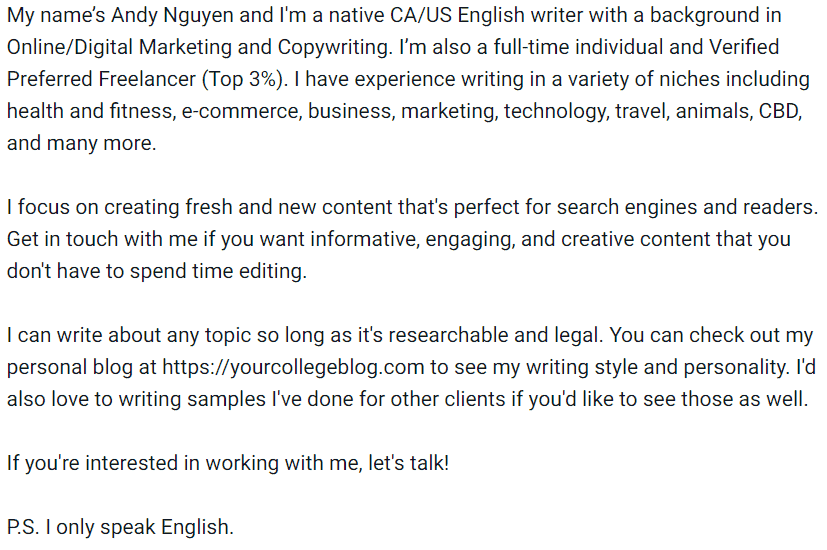
Don’t mistake your freelance profile for a resume. Of course, for resumes, you want to be as short and concise as possible. For freelance profiles, you still want to be as short and concise, but your goal is to give as much relevant information about yourself as possible. These key pieces of information are extremely valuable for clients who don’t get to meet you in person.
5. Define Your Target Clients

The next step is to define your target clients, but what does that mean?
Defining your target clients is outlining exactly who your potential clients may be so that you don’t end up wasting time working with the wrong client. Working with the wrong client can leave you with several problems, including poor communication, uncompleted work, exceeded expectations, and ultimately wasted time and effort.
How to define your target clients
1. Understand your situation
To define your target clients, you first need to understand the situation you’re in. Remember that you’re a new freelancer looking to land your first client on a platform you’ve never used before.
Depending on how qualified and skilled you are, you may not want to look for clients searching for the top freelancers in your niche. Instead, you might want to look for clients who are looking for new and inexperienced freelancers.
In other words, think about the types of clients that would want to hire you. Since you’re just starting, don’t overvalue yourself, even if you believe you’re worth it. It takes time to build up that value on any platform.
2. Define your ideal client
Think about who you want to work with. It’s possible to find bad clients who rarely come online, come up with lies, have terrible communication skills, and try to cheat you.
Therefore, you should have a good understanding of who you’re willing to work with. Remember not to let unethical clients take advantage of you just because you’re a new freelancer. I’ll teach you how to deal with bad clients later on.
6. Learn to be More Personal
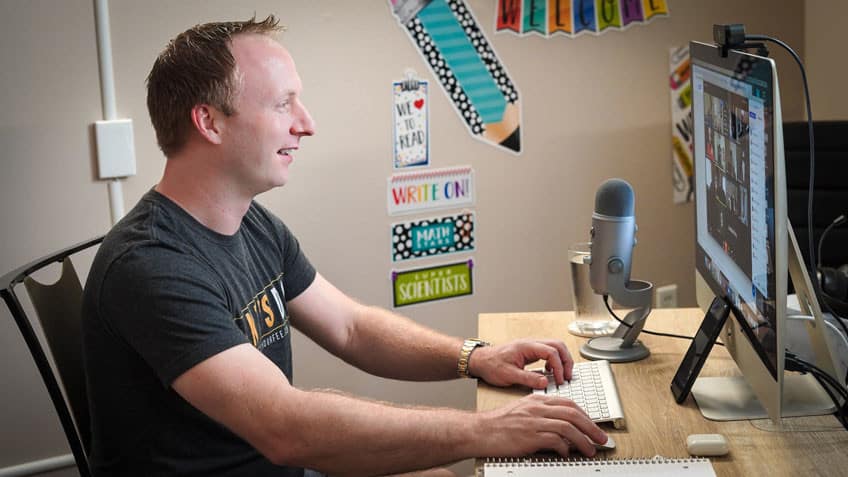
Before you start talking to any client, you need to learn how to be more personal, even if you consider yourself an industry professional.
Learning to be more personal allows you to connect and build healthy relationships with your clients. As a result, you’ll land more jobs. Remember that clients on these platforms are talking to dozens of freelancers daily.
They want to find someone who they like and trust, similar to real life. For some clients, if you’re speaking too professionally or robotically, you might lose them entirely.
How to be more personal
1. Talk to your clients as if it were face-to-face
This is single-handedly the best thing you can do to be more personal online. Learning to talk to your clients as if you were meeting them in person can build a much more trusting, genuine, and healthy relationship.
You can start conversations like this:
“Hey John! How’s your day?” This sets a friendly mood and gets the conversation going. In short, keep the language conversational and not transactional.
2. Use “I” and “you” more often
There’s nothing less personal than using “us” or “we” in a sentence. Using those will make your client feel like they’re talking to a third-party figure. Instead, you “I” and “you” to give a feel of direct communication between you and your client.
3. Ask relevant questions
To show clients that you’re genuinely interested in their work, you need to ask questions. Ask questions that’ll help you complete the work should you be hired for the job. You should be doing this not just to be more personal but to ensure that you can complete the work correctly.
4. Acknowledge what your client has to say
Showing your client that you’re actively listening is a great way to be more personal. As the conversation progresses, acknowledge what your client has to say.
For example, if your client tells you that they had a major drawback last year, tell them that you’re glad they managed to overcome it. As long as you’re being genuine, this is an excellent way to build a healthy relationship with your client.
5. Show your appreciation and make it all about them
If a client reached out to you and told you they like your portfolio, say, “Thanks for reaching out, and I appreciate the compliment.”
Showing your appreciation is valuable when looking to work with long-term clients.
When speaking to your clients, always steer the conversation around them. Talk about how you can help them with their problems, rather than what you’re good at.
7. Craft Your Proposals and Bid to Get Your First Client

Now that you have the entire framework set up, it’s time to create the perfect proposal to help you land your first client. Keep in mind that a proposal can also be called a bid.
Crafting the perfect proposal is one of the most important steps which can make or break your success, so be sure to follow along carefully.
To secure your first client, you’ll be bidding on jobs along with many other freelancers. The client will then go through the entire list of freelancers, reach out to the ones they’re most interested in, and then decide on the winner. Hopefully, you.
How to craft the perfect proposal
In reality, there is no perfect proposal as every client will find one proposal more appealing than another. However, certain elements make up a good proposal. Here are seven guidelines you need to follow.
1. Tailor your proposal to fit the job description
One of the biggest mistakes you can make is copying and pasting the same proposal for every job posting. If you do this, your proposal might not even be relevant to the job description. Every regular client knows that lazy freelancers copy and paste, so make sure you tailor your proposal accordingly.
For example, let’s say you’re a graphic designer. Your proposal includes “designing amazing logos,” but the job asks you to design a banner instead. Get rid of the logo part and tailor your proposal to make it sound like you can create the best banner possible. Copying and pasting generic information about yourself is fine as long as you tailor the important parts.
2. Be honest
Just like a real job, it’s a terrible idea to lie about your skills and what you’re capable of. This will only backfire on you as you start working on the job and fail to carry out tasks. You’ll eventually have to tell your client that you’re unable to complete the work, and you’ll end up with a bad review. This will make it even harder for you to land more jobs in the future.
3. Keep it short and concise
As you know, clients are reading through hundreds of proposals every day. Therefore, you need to make sure your proposal is short but still concise and compelling. When you wrote your freelance biography where I recommended learning to create an elevator pitch, you should bring the same ideas here.
Explain a little about who you are, what you’re skilled at, what you have to offer, and what makes you the best candidate. Your proposal may be very similar to your biography like mine is.
4. Provide social proof
Clients prefer those who have previous work experience. Therefore, you’ll want to provide any social proof you can of your work. This is where you can link your portfolio or provide direct links to relevant work you’ve done.
5. Keep it conversational
As you’ve learned in the previous step, you’ll want your proposal to be personal and written in a conversational way. Show your client that you’re a real human being who’s ready to start and build a healthy relationship.
6. Give your clients a reason to reach out to you
Crafting a good proposal is like being a salesperson. You need to give your clients a reason to get back to you. Be creative and think outside the box. For example, you can include in your proposal that you’re willing to do a free work sample for them to evaluate your skills.
7. Be unique and never copy a template
Don’t copy exactly what other freelancers are doing in their proposals, including mine. Do something with your proposal that’ll make you stand out from everyone else. Likely, what works in one niche might not work in another, so I highly recommend that you make your proposal unique.
After you think you’ve crafted the perfect proposal, try preparing two more. Because, as I said, there is no perfect proposal. You’ll want to test each of your “perfect” proposals to see which one lands you the most jobs.
Taking it a step back, see which one leads the most clients to reach out to you in the first place. Use each one for at least one to two weeks before moving on to the next.
Crafting a proposal for new freelancers
If you tried crafting perfect proposals but aren’t finding any luck, you can try using some of these methods which may work better for new freelancers. I used some of these methods in my proposal when I first started, and they helped me land my first few clients, at least in the writing niche.
1. Give them a reason to give you a chance
Although clients do prefer experienced freelancers, you still have a chance to compete with them using a well-crafted proposal. Talk about how you’re a new freelancer who is looking to kickstart their freelance career.
Really sell the fact that since you’re new, you’re willing to put in extra effort to prove that you’re worth the shot. Just be careful not to make any promises you can’t keep.
2. Provide a free work sample or test
I’m not a fan of working for free. However, it might be a good idea when you’re just starting. Let your clients know that you’re willing to complete a work sample or test to show that you’re able to do the job. This also works as a safety net in case you’re unable to do the job.
3. Go the extra mile
In your proposal, let your client know again that you’re new to freelancing and that you’re willing to do more than what they expect. However, you should be specific.
For example, say you’re a graphic designer, and a job asks you to design a logo. You can tell your client that you’re willing to make two other logo variations to see which one they like best. There are countless ways to go the extra mile, so get creative with it.
4. Focus on selling your portfolio
Since you don’t have any reviews on your profile, you can try to really sell your portfolio. Find relevant work samples in your portfolio, share them with your client, and then explain how you can do the same or even better work for them.
My freelance proposal
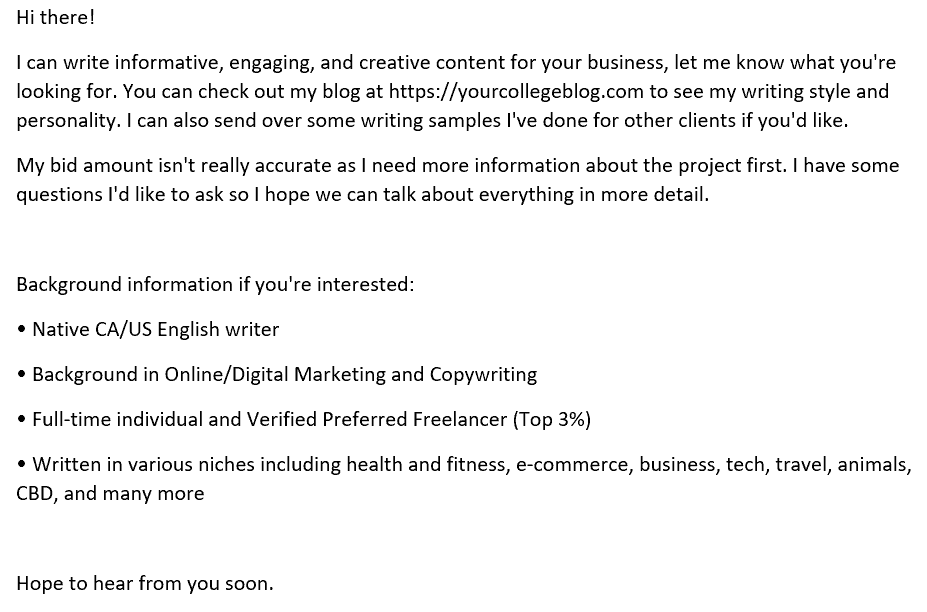
Getting Your First Client
Once your proposals are ready, you can start working on getting your first client by bidding on jobs.
Make sure you’re bidding every single day. All it takes is one great client to kickstart your freelance career, so you don’t want to miss out on a day of bidding. One of your priorities is finding that perfect client who has a lot of work to be done and is willing to pay well.
Keep in mind that this guide only teaches you to find clients on freelancing platforms. There are ways to bring clients to you, but I believe that’s for those who are more experienced.
How to bid on jobs to get your first client
First, you need to know the difference between a bid amount and a proposal/bid. A bid amount is the amount of money you’re charging your client to complete their job, and this can be per hour or for the entire job. A proposal is the written portion that explains why you’re a good fit for the job.
I firmly believe that you need a well-thought-out strategy to bid on jobs because you can run out of bids, assuming you’re using a free or cheap plan. When you run out of bids, you’re forced to either upgrade your plan, purchase more bids, or wait until your bids replenish.
Every freelance platform has a different bidding system, but the only one I’ll be going over is Freelancer’s. However, you can take the same ideas I talk about and apply them on any platform.
Please note that the following is how I bid on Freelancer and have found the most success doing. What works or doesn’t work on Freelancer may differ on another platform.
1. Only go through the last 24 hours of job postings
I found that once jobs have been posted for over 24 hours, clients very rarely reach out. However, if you have extra time and a significant number of bids laying around, you could apply to jobs posted over 24 hours.
2. Avoid clients that have not verified more than their email
Freelancer verifies every email. Still, I found that if a client doesn’t verify more than their email, they either never reach out to you or try to cheat you somehow. Learn about the 10 red flags and warnings on Freelancer.
3. Avoid clients that just created their accounts today
I also found that almost every client who just created their account today is also trying to cheat you somehow. Unless they have more than just their email verified, I’ll avoid them altogether.
It’s unfortunate because there may be legitimate clients who created their accounts today. I’m just not a fan of guessing which ones are legit or not.
4. Don’t set your bid amounts too high
For some clients, their budget takes priority. So, if you’re bidding too high, you could scare them off. You might also not get all the information you need from a job description, so it can be hard to place a proper bid amount.
It’s safer to bid low and then negotiate your bid amount when a client reaches out to you. I include in my proposal that my bid amount might not be accurate as I need more information about the project first.
Whatever your client’s budget may be, for example, $50-250, you should always be bidding closer to the lower end as a new freelancer. It’s a good idea to be one of the “cheaper freelancers” for now until you’ve built your profile.
5. Set a shorter delivery time
In your proposal on Freelancer, you can set an expected delivery time for you to complete the job. I always put a shorter delivery time as it’s more appealing than a longer one, assuming it’s realistic. Again, you might not know the full scope of the project, so you can always ask for an extension if you think you’ll need it.
I hope I didn’t make Freelancer seem like an unreliable platform, because it’s not. As long as you follow points 2 and 3 above, you’ll be perfectly fine. Every platform is vulnerable to scams and unethical people. It’s your responsibility to avoid these scams, and I’ll do my best to help you, at least on Freelancer.
Example of placing a proposal/bid on Freelancer
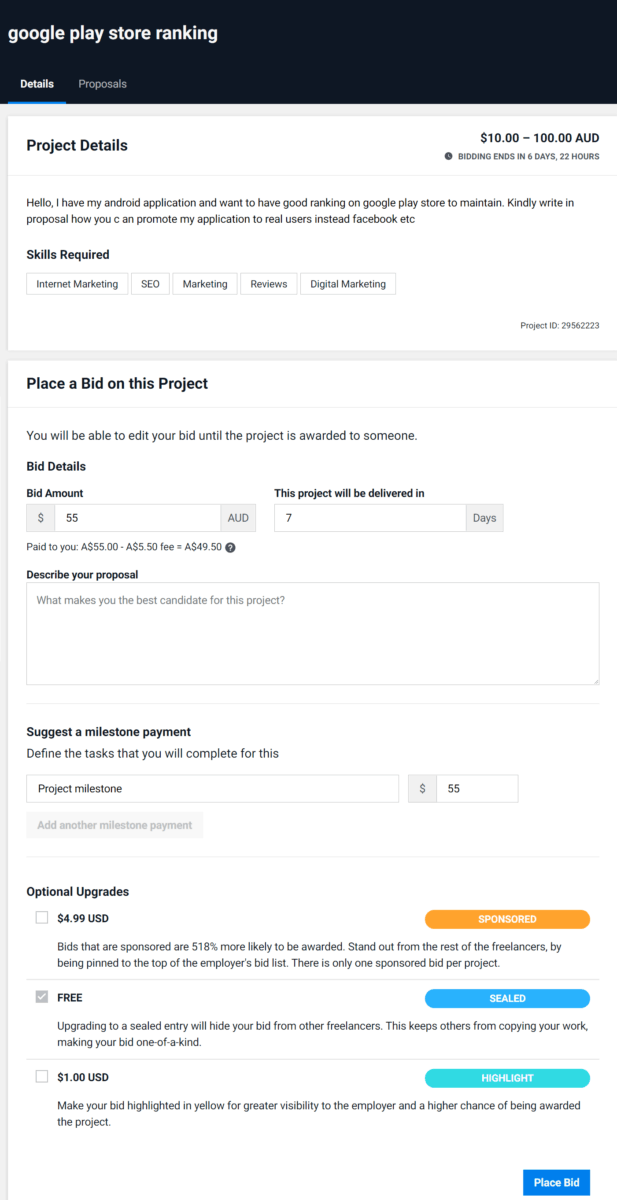
8. Follow up with Clients and Set Expectations
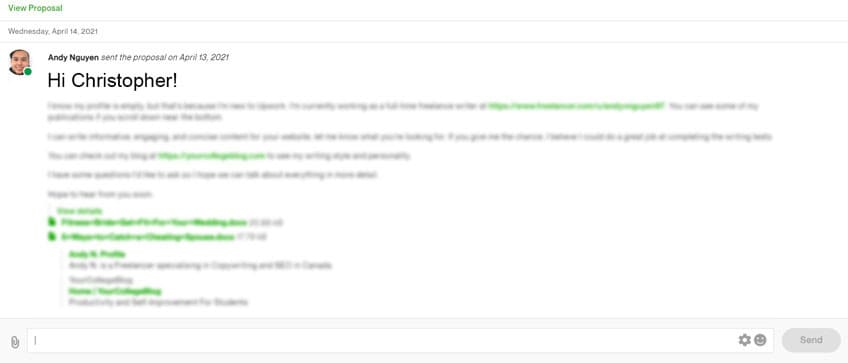
It’s excellent news if you’ve made it this far. At this point, you’ve been applying to jobs, and now somebody has reached out to you.
Don’t forget that even though a client has reached out to you, it doesn’t mean you’re their final pick. They could be evaluating several freelancers like a regular job. This step is basically an interview where your client will ask you questions to see if you’re a good fit or not.
You need to learn how to properly follow up with clients to increase your chances of getting hired. It’s possible to get hired right away as well. Just make sure you clearly set expectations with your clients before accepting the job, so there are no surprises.
How to follow up with clients
1. Check over the job description before you start the conversation
A client may follow up with you days after you applied to their job. Some job descriptions can also be very lengthy. Therefore, you’ll want a quick refresher of what the job’s about before talking to your client.
2. Continue to be personal
Use everything I explained in Step 6 to be more personal with your client. To start, always say “Hello” and thank your client for reaching out to you. Asking relevant questions is key. You need to let your client know that you’re genuinely interested in their job and make sure you can actually get the job done.
3. Don’t be desperate
You should never beg your client to hire you or to give you a chance. It shows a lack of confidence and professionalism. Even if you do this once, you could completely ruin your chances of securing the job. Stay cool, calm, and collected at all times.
4. Close the deal
Remember that your goal when following up with clients is to close the deal. To do so, keep selling based on your proposal. Even though your proposal is supposed to be short and concise, you now have the opportunity to sell yourself even more.
Whatever it is you decided to sell in your proposal, push it further! Show your client that you’re confident and serious about getting the job done. The entire conversation should revolve around how you can help them complete their job, and why you’re the best candidate.
If you’re talking about your skills and experience, always relate to how they’ll help complete the job. Don’t just list skills you can easily find on your profile or in your proposal.
Setting Expectations
If you’re doing a good job following up with your clients and they seem interested, you should now set expectations.
What does it mean to set expectations with clients? Setting expectations is ensuring that both you and your client are on the same page about all the project details. There should be no surprises at any point during the job. Both the client and you need to set all expectations before you start any work.
How to set expectations with clients
1. Be honest at all times
When setting expectations with your clients, you need to be honest with yourself and your client to complete the job. If you don’t think you can complete a job well on time and budget for whatever reason, you need to let your client know.
2. Communicate as clearly as possible
When speaking with your client, you should do so in a conversational way. You should also be using simple language that won’t cause any confusion. If your client is speaking in terms you don’t understand, you need to let them know. Have them clarify anything you’re even slightly confused about.
3. Confirm your bid amount with your client
After getting a better understanding of the project details, you should then confirm your bid amount with your client. It should be as straightforward as:
“For completing X, I will be paid Y.” If you’re using Freelancer, always make sure the client creates milestone(s) before you start working.
4. Confirm the due date
Make sure you know exactly when the job is due. If the job is due in “3 days,” ask your client for a specific time and in which time zone. Remember, you could be working with clients from all around the world in different time zones.
5. Confirm any other requirements and deliverables
Some clients may have specific requirements they want you to do, such as coming online every day at 10:00 A.M. PST for a quick meeting. Whatever the requirements may be, you’ll want to confirm them.
6. Confirm communication expectations
If you’re someone who expects their clients to communicate in a certain way, you should confirm any expectations you have with them. However, you shouldn’t be too picky. This can include receiving timely responses and being respectful. You can come across rude and disrespectful clients, so be sure to set clear communication expectations.
If you find that it’s too difficult to set clear expectations with a client, don’t be afraid to walk away, even if it’s the first client who reached out to you. Setting clear expectations is a must as it’ll ensure that the job goes smoothly. Without setting clear expectations, you get into the situation of “he said, she said.”
9. Complete the Work as Promised
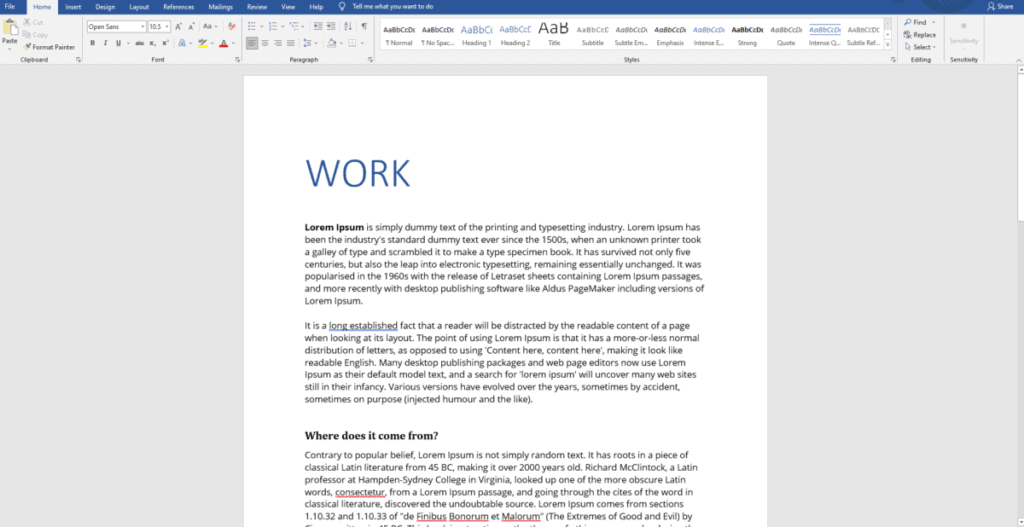
Congratulations on being awarded the project!
If you reached this step, it means your client chose you as the winner. This is a huge accomplishment because you were competing with dozens of other freelancers and won.
As a new freelancer, reaching this step will be difficult. In fact, it’s one of the hardest things to do when you’re just starting.
I can assure you that from here on, it only gets easier. Once you start working with a few clients, you’ll get the hang of how everything works. You’ll also figure out your own unique method of landing clients.
Now, it’s time to complete all the tasks your client has assigned to you.
How to complete freelance jobs successfully
Now that you got rewarded the project, you have the responsibility of getting the work done. Here are five ways to successfully complete freelance jobs.
1. Live up to the set expectations
Since your clients and you set expectations, you need to live up to them no matter what. Of course, if something comes up and you can’t follow through, you need to let your client know right away.
Unfortunately, your client might not be happy about this, so try not to break any expectations. This is especially important when it comes to budget and due dates. There’s nothing worse than letting your client know you’ll need an extra few days to complete a task or job without a good and reasonable excuse.
2. Triple-check everything
Before submitting anything to your client, check your work multiple times to ensure you did everything right. Some clients will pay you, end the project, and leave you with a bad review if they receive low-quality work.
Although it may seem unfair, it’s not against the rules. To avoid this, you can let your client know that you’re willing to make reasonable revisions.
3. Keep your client updated
Rather than waiting to hand everything in only when you’re done, keep your client updated while working on the job. Send them deliverables that you complete to receive early feedback that may help you finish other tasks or the rest of the job.
4. Stay organized
The more freelance jobs you complete, the more files, images, and folders you’re going to have everywhere. You need to make sure your computer, including the software and tools you use, is organized and easy to navigate. This guarantees you don’t hand in or work on the wrong file. You may be working with multiple clients at once, so organization is key.
5. If possible, deliver earlier than promised
Clients love freelancers who can complete tasks quickly because they can assign them more work that’ll help grow their business. Handing in work early also acts as a safety net if some changes or revisions are needed before the due date.
This doesn’t mean you should rush to hand things in. Delivering quality work should always be your top priority.
Here’s a secret. Try not to always hand in work early as your client may feel like they have overpaid for your services – similar to working a salary-based job.
How to deal with bad freelance clients
As I’ve mentioned, while working on your freelance jobs, you might come across bad clients. Learning to deal with these clients is important because you will come across them at some point.
Again, you’ll have clients who have poor communication skills, never come online, lie about project details, and try to take advantage of you. Here’s how to deal with them:
1. Ensure clear expectations have been set for the job
As you learned, setting expectations ensures that both you and your client are on the same page about all the project details. You’ll always have these expectations to refer back to if a bad client tries to lie about something.
2. Be aware of all terms and conditions, guidelines, and rules
If you know exactly what you’re allowed and not allowed to do, you’ll never let a bad client get you in trouble or try to take advantage of you. For example, on Freelancer, it’s prohibited to ask freelancers to communicate off the platform, i.e. Skype, What’s App, email, etc.
The platform does this to protect freelancers from shady off-site scam tactics. For example, a client asks you to do more work for extra pay off the platform but never pays.
3. Keep it professional and contact the support team if needed
No matter how bad the relationship may get between you and a client, you should always keep it professional. Never throw insults or act irrationally because it won’t look good on your part. If you can’t resolve an issue, you can escalate the situation by contacting support and ask for help.
4. Be the bigger person
If you’re working a job and your client is rude in some way, try not to let it bother you. Be the bigger person and do your best to get the job done quickly. If you’re using a reliable platform, you’ll get paid for your work as long as you deliver what’s expected.
If you decide to stand up for yourself, make sure you do so in a respectable way. Personally, I have no problems working with bad or rude freelance clients as long as they continue paying me.
5. Address issues right away
If you find issues that make it difficult for you to complete a job, you need to address them with your client immediately. An example of this could be needing to communicate daily with your client, but they’re never online.
Don’t let the problem linger as it may affect the way you work or cause you to miss the deadline. You want to make sure you can provide the best work possible, so address any issues right away!
10. Get Repeat Clients and Land New Ones

The last step of this guide is to focus your efforts on getting rehired by previous and existing clients. You’ll also focus on landing even more clients to maintain a steady income stream.
As a freelancer, you always want to establish long-term relationships with your clients because it drastically increases your chances of getting rehired.
One of the biggest problems freelancers struggle with is finding enough work. That’s why working with repeat clients is so valuable. Having repeat clients, or long-term clients rather, means that they have more than one job for you.
And with the right client, you might not even need to find more.
The workload might be too much for you to handle, but this is a good problem to have in this case. If you ever reach that point, you can consider outsourcing your work and changing your profile into a corporate one. However, I won’t be getting into that in this guide.
Why you should work with repeat clients
Aside from maintaining a steady income stream, here are some other reasons why you’ll want to work with repeat clients:
- You’ve already established a relationship. If you’re working with the same client, you already have an existing connection to go off. You don’t have to start again with the introductions and formalities like you would with a new client. You also don’t have to sell yourself over again.
- Familiar or same expectations. Since you’ve already done some work for your client, you’ll most likely have the same expectations to work off. This makes it easier for you to get work done because you already know what your client expects. Of course, your client can set new expectations, but it’s still easier than starting with a new one.
- The work gets easier. Since you already have an existing relationship and know your client’s expectations, the work you’re doing gets easier. You start to get used to the job, but that’s assuming you’re not doing several different things for your client.
- You start to become an expert. As you’re working with long-term clients, you need to realize that you’re consistently refining and improving your skills. You’ll also become much more knowledgeable of the niche you’re in. The longer you work with a client, the more experience you’ll get and the more of an expert you’ll become.
- You’re able to receive bonuses. If you’re able to maintain healthy relationships with your clients, you may be able to receive bonuses. These types of bonuses include tips, an increase in pay, a promotion, etc. (A promotion is possible if a client treats your freelance job as an actual job position).
You should only consider working with repeat clients who have proven to be good. Decent at the very least; if you continue working with bad freelance clients, it’s up to you to handle any problems that arise.
How to get repeat clients
Getting repeat clients is easier than you think, but let’s think about it logically.
Say you completed quality work for a client on time and budget. In other words, you did everything your client expected of you. Why wouldn’t they want to rehire you?
Sure, they may be able to find somebody else who can deliver the same work as you at a lower cost, but that’s a risk they have to take. They’ll have to go through the entire hiring process again, which can be very time-consuming and unproductive. Knowing this, let’s discuss how you could get repeat freelance clients.
1. Build a healthy relationship from the start
The sooner you can establish and build healthy relationships with your clients, the more likely they’ll come back to hire you. Of course, that’s assuming they have enough work for you to do.
You need to show your clients that you’re genuinely interested in helping them grow their businesses and that you’re not just in it for the money. It’s easy to tell when someone simply wants to get paid for their work and then move on.
2. Position yourself as a valuable partner instead of a commodity freelancer
This only becomes important when you become a more experienced freelancer. Rather than trading your services in exchange for money and then finding the next client to work with, you should work on positioning yourself as a valuable partner.
In other words, work on becoming a valuable asset for your client’s business. Put in extra effort to deliver more than what you promised. Make your clients feel like they need to YOU whenever they need work done.
3. Expand your skillset and offer additional services
If you completed a job for a client and they were happy with your work, you could offer additional services which they could be looking for. Since you already did an excellent job with the initial service and have established a relationship, the client will be far more likely to work with you again.
You’ll need to live up to the same expectations as the first job. By expanding your skillset, you’re able to offer multiple services that could meet the needs of a single client, thus making them a long-term client.
4. Reach out to previous clients
Just because a previous client said they don’t have any more work doesn’t mean they’ll never have more work for you. You should periodically check in on previous clients to see how they’re doing. This shows them you care about the relationship.
It’s also possible that a client might’ve forgotten about you. Therefore, reaching out could remind your clients of your hard work. Again, you should always reach out genuinely. Don’t just send your previous clients a message asking them if they have more work for you.
5. Stop selling yourself and start upselling
After you’ve worked with a client, you don’t need to continue selling yourself because they already know what you’re capable of. Instead, you should start upselling, a common sales technique that’ll earn you more money from a single client.
Upselling is offering your clients additional purchases that complement or upgrade the services you’ve already sold. For example, let’s say you’re building a website for your client. You could upsell them by offering an upgraded version that is more stunning and has advanced and unique features. You can also offer to set up their social media pages and link the website to them.
6. Offer a loyalty deal
Every client wants to work with a freelancer who can provide excellent services at a reasonable price. Therefore, after you’ve provided a client with some services, you can offer them a permanent or temporary loyalty deal that’ll entice them to work with you some more.
If the work you’re doing is difficult, you don’t want to offer a huge discount won’t make it worth your time. The discount should be within reason and still earn you a good amount of money. In fact, if you don’t have any long-term clients, the loyalty deal will earn you more money because you wouldn’t have regular work in the first place.
How to land new clients with experience
Now that you started building up your profile with reviews, ideally 20+, you can optimize and refine your strategy to land more clients. Here are five things you can do.
1. Refine your proposal
With some real freelance experience under your belt, you can now refine your proposal to make it more appealing for new clients. For example, if you sold the fact that you’re a new freelancer looking to put in hard work, you can now change it to explain the type of services you offer and why they should choose you.
Don’t go over the top by claiming you’re the best freelancer in the world. Instead, be realistic with your skills and continue to give new clients a reason to hire you over highly experienced or veteran freelancers.
2. Refine your freelance biography
Similar to refining your proposal, you’ll want to update your freelance biography to make it more appealing for new clients. Take the same ideas I talked about when refining your proposal to refine your biography as well.
3. Continue filling out your freelance profile
Take everything you learned in Step 4 to continue filling out your freelance profile. You should be completing more tests and certifications, updating new publications, skills, and qualifications you’ve made, and listing any testimonials you’ve received.
4. Update your portfolio
After working with several clients, you may be able to update your portfolio with work that better demonstrates your skills. Consider replacing items from your portfolio with better work samples rather than uploading everything.
5. Upgrade your membership plan
If you find that you’re starting to run out of bids quickly or you want to unlock and earn new features, you should consider upgrading your freelance membership plan. The more expensive plans usually offer several benefits on top of new features, so be sure to check them out.
6. Bring clients to you
Now that you’re an experienced freelancer, you can start focusing on attracting clients to your services. You’ll need to gain some marketing and networking skills. But don’t try to tackle everything at once. Start by creating a simple website that includes your portfolio and lists the services you offer.
Biggest Mistakes New and Experienced Freelancers Make With Solutions
You’re bound to make mistakes as a new freelancer. Many of them, to be more specific. It’s okay to make mistakes as long as they don’t get you banned from the platform you’re using or cheated from hundreds or thousands of dollars. Even as an experienced freelancer, you’re still going to make mistakes, many of which you probably don’t even notice.
Let’s talk about some of them.
Mistakes new freelancers make with solutions
1. Giving up quickly
Many new freelancers give up quickly because they’re unable to secure their first few clients. However, this is the most important thing you need to do as a new freelancer!
Once you’ve secured a few clients and they leave reviews on your profile, the next few will come easier because there’s proof that you completed real work on the platform. Personally, it took over half a year to secure my first client. I then secured my next clients a few months after that.
Solution: Stay determined, be consistent when you see results, try out new strategies and tactics, and most importantly, never give up!
2. Only applying to high-paying jobs
Like I said before, you need to undervalue yourself until you’ve built up your profile with reviews, even if you have the skills already. Clients on freelancing platforms want to work with experienced people who have completed many relevant jobs.
Solution: For now, you should be applying to any paying job that you can land, as it’ll help build your profile. Once you have a handful (20+) of good reviews, only then should you start worrying about applying to jobs with better pay.
3. Accepting jobs you can’t complete
When you don’t have any freelance experience, you might get desperate to accept any job you can get. Unfortunately, this can actually hurt your freelance career. Taking jobs that you can’t complete will only lead to a bad one-star review on your profile and unpaid work.
To make matters worse, your client may leave a written review that explains your poor work. This will make it even harder for you to land new clients.
Solution: Before accepting a job, take some time to evaluate whether you can do a good job with it or not.
4. Failing to meet set expectations
As you’ve learned, setting expectations is very important. Failing to meet the expectations that both you and your client agreed on can tarnish the relationship. What could’ve been an amazing long-term client is now a client of the past.
Solution: Ensure reasonable expectations have been set and follow through with them no matter what.
5. Letting your emotions get in the way
When it comes to business, you should never let your emotions get in the way because they can negatively affect the way you work. Working with negative emotions will lead you to deliver poor work, be stressed, and leave you feeling angry or even sad.
Solution: Do your best to always think rationally, keep a professional demeanor, and never let personal issues stir up your emotions.
6. Doing work you don’t like
With anything, it’s easy to tell when somebody doesn’t like the work they’re doing. If you want to become a successful freelancer, you need to like what you’re doing – it’s as simple as that.
The more you enjoy the work, the higher quality work you’ll deliver. You’ll also have a good time working on jobs rather than trying to push through them as fast as possible.
Solution: Only accept work that you enjoy doing, at least a little bit.
7. Leaving things to the last minute
Deciding on finishing your freelance work at the last minute is a huge mistake. If a problem suddenly arises that prevents you from meeting your set expectations, you’re going to end up with a disappointed or even angry client.
Solution: Aim to finish your freelance jobs as soon as possible without compromising on quality.
8. Taking on too many clients
Yes, even new freelancers can make this mistake if they’re fortunate enough to secure several clients early on. When you’re starting as a new freelancer, it’s tempting to take on every client that offers you a job.
Unfortunately, you’ll end up with too much work on your hands and may fail to deliver. This is especially true if you’re working a daytime job or have other responsibilities to take care of.
This can leave you feeling very stressed, overwhelmed, and worried about upsetting your clients. If a job offer seems too good to give up, ask the client if you can get started at a later date. Or, spend some late nights finishing as many jobs as possible.
Solution: Accept and work with as many clients as you’re able to handle without overwhelming yourself.
9. Outsourcing your work
There are many reasons why new freelancers might want to outsource their work. Maybe they’re too lazy, unqualified, or simply have too much work on their hands. Whatever the reason may be, it’s a huge mistake to outsource your work as a new freelancer.
You need to gain as much experience as possible to quickly adapt and get familiar with the work you’re doing. The more work you do yourself, the more skillful and valuable you become. Another problem with outsourcing is delivering inconsistent work to your clients.
Solution: When starting, do all the work yourself and reject any jobs you can’t complete. If for some reason you decide to outsource your work, always make revisions that’ll bring the work up to par with your quality.
10. Treating clients like friends
It’d be nice to see clients as friends in a perfect world, but unfortunately, everything comes down to business. If you’re working with a client halfway across the world, they’re not going to care about your personal problems. Of course, you’ll meet nice freelancers who will, but the vast majority won’t.
They simply want their job done well. Clients can be tough to deal with, but if you set expectations, you again need to live up to them no matter what.
Solution: Avoid treating clients like friends unless you’ve built a genuine and long-term relationship with them. Otherwise, keep it professional (but still friendly) and meet the set expectations.
Final Thoughts
The best feeling in the world is getting your first freelance client. It was for me at least.
It gives you proof that it’s possible to make money online doing something you’ve never done before. It’s also very exciting to know that you can take your freelancing career to a much higher level if you do it right.
I hope you found this guide helpful. I wish you all the very best of luck in your journeys.
What did you think about this blog? Comment below! Also, subscribe to my newsletter for updates on new content, including videos on YouTube!


